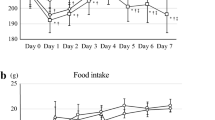Abstract
Studies of an intensified chemotherapy of FT-207, combined with MMC, have been under way since April 1977 in the First Department of Surgery of Chiba University Hospital and five closely related hospitals. These studies were performed on 114 patients with curative stomach cancer. The 114 patients received intravenously 0.4 mg/kg and 0.2 mg/kg of MMC on the operation day and the next day, respectively, and then intravenously 800 mg of FT-207 daily from the 10th postoperative day until discharge, followed by oral administration of FT-207, 600 mg, for more than 1 year after discharge. The 114 patients were divided into two groups. Half of the patients received 100 mg of phenobarbital and 30 mg/kg of glutathione for the purpose of induction of hepatic drug-metabolizing enzymes (induction group). Significantly higher levels of serum 5-FU released from FT-207 were observed in the patients of the induction group when compared to those of the control group. However, there was no statistically significant difference in survivals at both 12 and 24 months after operation between both groups.
Similar content being viewed by others
References
Breckenridge, A., Orme, M.L’E., Davies, L., Thorgeirsson, S. S. and Davies, D. S.: Dosedependent enzyme induction,Clin. Pharmacol. Ther. 14: 514–520, 1973.
Ernster, L. and Orrenius, S.: Substrate-induced synthesis of the hydroxylating enzyme system of liver microsomes,Fed. Proc. 24: 1190–1199, 1965.
Fujii, S., Okuda, H., Toide, H., Watanabe, N., Taira, K. et al.: Studies on the fate of 1-(2-tetrahydrofuryl)-5-fluorouracil (FT-207), a new antitumor agent (1). Absorption, tissue distribution and excretion,Ohyo-Yakuri 8: 589–595, 1974 (in Japanese).
Fujimoto, S., Akao, T., Itoh, B., Koshizuka, I., Kitsukawa, Y. et al.: Protracted oral chemotherapy with fluorinated pyrimidines as an adjuvant to surgical treatment for stomach cancer,Ann. Surg. 185: 462–466, 1977.
Fujimoto, S., Ishigami, H., Minami, T., Miyazaki, M., Itoh, K. et al.: Metabolism of 1,3-bis(tetrahydro-2-furanyl)-5-fluorouracil in mice.J. Natl. Cancer Inst. 63: 465–468, 1979.
Fujimoto, S., Itoh, K., Tazawa, T., Ichimura, K., Hosaka, T. et al.: Studies on protracted oral chemotherapy with fluorinated pyrimidines as an adjuvant to surgical treatment for stomach cancer, with special reference to cancer chemotherapy by hepatic microsomal enzyme induction,Jpn. J. Surg. Soc. 79: 1099–1104, 1978 (in Japanese).
Fujita, H.: In vivo distribution of antitumor agents—methods of assay (1)—Cancer and Chemotherapy 1: 497–503, 1974 (in Japanese).
Garfinkel, D.: Pig-liver microsomes. I. Enzymic and pigment composition of different microsomal fractions,Arch. Biochem. Biophys. 77: 493–509, 1958.
Hattori, T., Itoh, I., Miwa, K., Hirata, K., Fujita, H. et al.: Large amount administration of mitomycin C during gastrectomy,Jpn. J. Cancer Clin. 10: 96–105, 1964 (in Japanese).
Hattori, T., Mori, A., Hirata, K. and Itoh, I.: Five year survival rate of gastric cancer patients treated by gastrectomy, large dose of mitomycin C, and/or allogeneic bone marrow transplantation,Jpn. J. Cancer Clin. 19: 241–248, 1973 (in Japanese with English abstract).
Kaibara, N., Soejima, K., Nakamura, T. and Inokuchi, K.: Postoperative long term chemotherapy for advanced gastric cancer,Jpn. J. Surg. 6: 54–59, 1976.
Klingenberg, M.: Pigment of rat-liver microsomes,Arch. Biochem. Biophys. 75: 376–386, 1958.
Koshizuka, I.: Studies on the metabolism of N1-(2-tetrahydrofuryl)-5-fluorouracil in vivo influenced by phenobarbital and glutathione,Jpn. J. Cance Clin. 24: 127–132, 1978 (in Japanese with English abstract).
Ohira, S.: Cancer chemotherapy in relation to the level of microsomal drug-metabolizing enzymes (cytochrome P-450) in the liver,Jpn. J. Cancer Clin. 23: 720–733, 1977 (in Japanese with English abstract).
Wills, E. D.: Lipid peroxide formation in microsomes. General consideration,Biochem. J. 113: 315–324, 1969.
Wills, E. D.: Lipid peroxide formation in microsomes. Relationship of hydroxylation to lipid peroxide formation,Biochem. J. 113: 333–341, 1969.
Author information
Authors and Affiliations
Rights and permissions
About this article
Cite this article
Fujimoto, S., Itoh, K., Tazawa, T. et al. Intensified cancer chemotherapy by induction of hepatic drug-metabolizing enzymes as a trial for the treatment for stomach cancer. The Japanese Journal of Surgery 10, 27–33 (1980). https://doi.org/10.1007/BF02468643
Received:
Issue Date:
DOI: https://doi.org/10.1007/BF02468643




